All About Seafood
Seafood is any form of sea life regarded as food by humans. Seafood prominently includes fish and shellfish. the term “seafood” is extended to freshwater organisms eaten by humans, so all edible aquatic life may be referred to as seafood. The harvesting of wild seafood is known as fishing and the cultivation and farming of seafood is known as aquaculture, mariculture, or in the case of fish, fish farming.
seafood FARMING TECHNIQUES
Aquaculture, mariculture, and aquaponics are names used for a variety of farming techniques for fish, seafood, and marine produce. The techniques are used for freshwater and salt water fish and are employed in above ground tanks, ocean pens, and in open waters. Fish farming produces a steady supply of fish that are raised in a carefully controlled environment
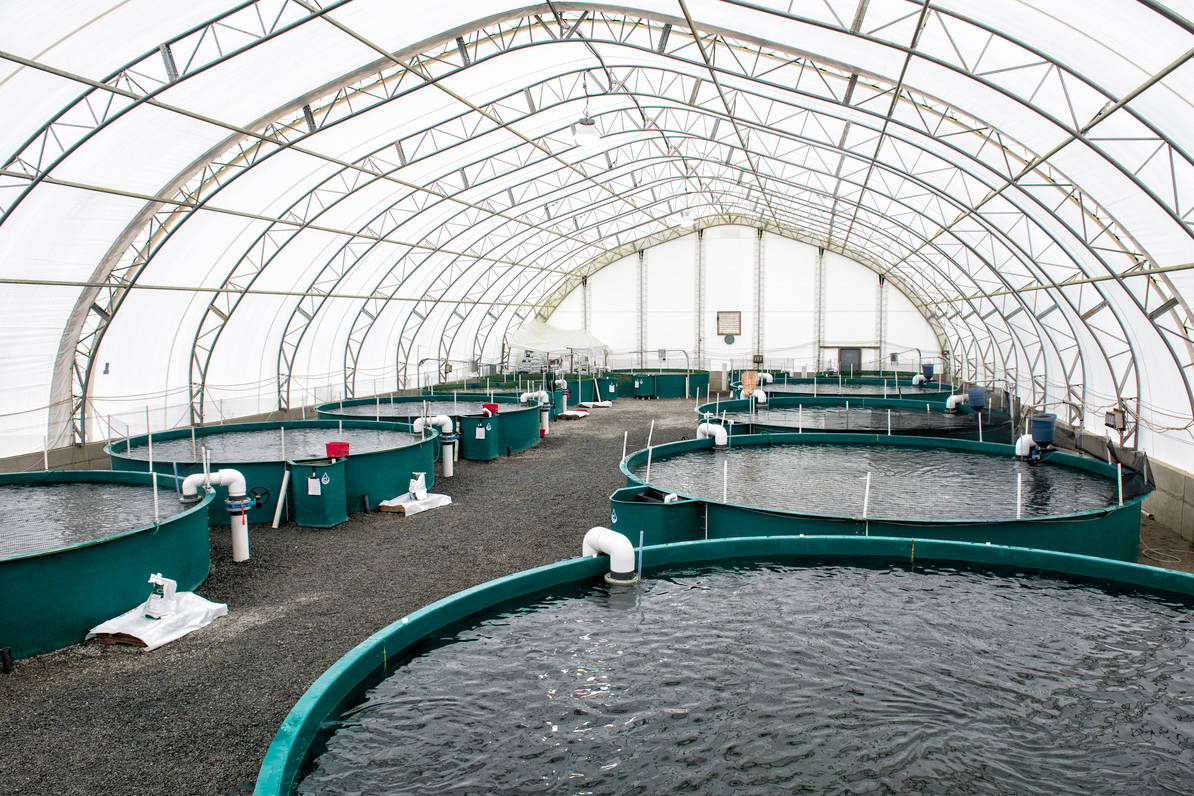
Common Farmed Fish & Shellfish

Fish & its classification
Fish are aquatic vertebrates with fins for swimming and gills for breathing. Fish are vertebrates and have skin and scales, which cover the body and they move with the help of fines. In many places around the world, especially in Bengal , India , fish is considered to be vegetarian food ,and it is called ’vegetable of sea’. Fish holds a special place in French classical menu, where it forms a separate curse called Poisson. Fish and shellfish can be used in almost any kind of preparation.
Composition of Fish
Fish is composed of 70-80% water, 15-20% proteins, 1-13% fat, and 1% minerals. Fat, also known as lipids, contains important omega-3 fatty acids that provide health benefits by helping to lower cholesterol and blood pressure.
The proteins in fish are different from meats because rather than bundles of muscle wrapped in connective tissue they are instead layered with collagen creating a “W” or wave-like appearance that creates a flaking effect when cooked. Fish collagen is layered between the folds of the muscle tissues and is weaker than animal connective tissue. This means that fish do not have to cook for long periods of time to make them palatable. Fish collagen melts into gelatin at about 120˚F/60˚C. Fish that are in colder waters tend to be fattier than warm water fish.
CLASSIFICATION OF FISH:
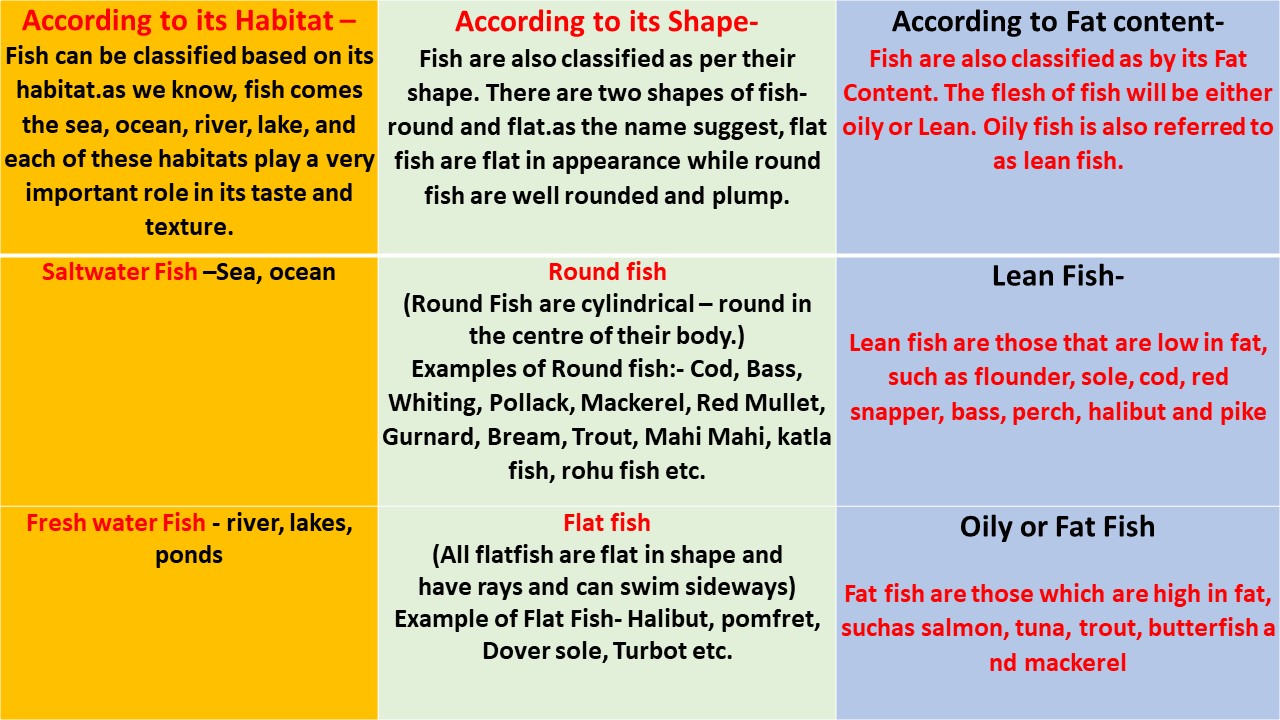
SKELETAL STRUCTURE OF ROUND FISH & FLAT FISH
For most fish the skeleton is made of bone, but some varieties, including shark, skate, and ray, are made of cartilage. The skeletal structure, along with the size of the fish, determines how fish are filleted.
 | 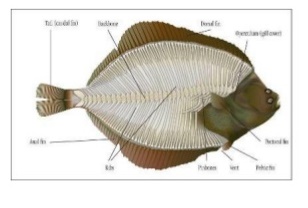 |
Most Popular Fish from India & Around the world used in Hotel Industry.
Sea Bass
Found wild from the Mediterranean to Norway in spring and summer, sea bass can grow up to 7kg. this highly rated fish is not only considerably more affordable, but available in plentiful supply all year round. The only significant difference is that farmed bass have a slightly higher fat content. Sea bass has a delightful flavour which stands on its own, but also works with stronger flavours, and is particularly popular in Thai cuisine. There is also a variation of the European sea bass called striped American bass, also a farmed freshwater fish, but without the typical earthy freshwater taste.
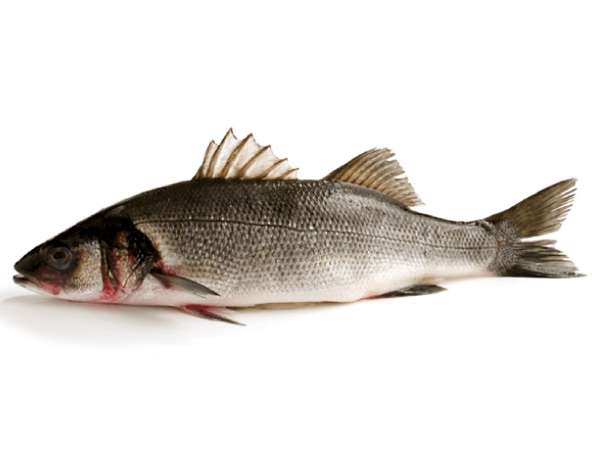 |  |
Rohu Fish:- Rohu is a species of carp family, found in rivers of Indian subcontinent and extensively used in aquaculture. Rohu is very commonly eaten in Bangladesh, Nepal, Pakistan and the Indian states of Tripura, Nagaland, Bihar, Odisha, Assam, West Bengal, Andhra Pradesh and Uttar Pradesh.
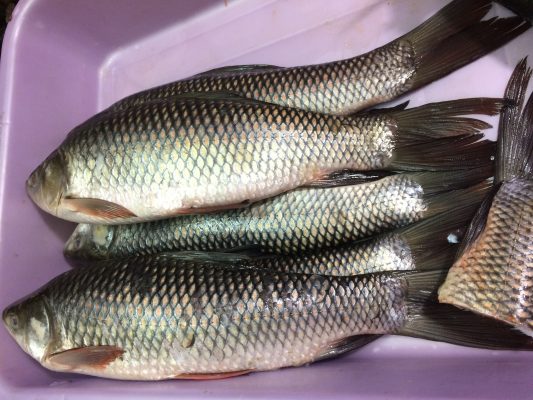 | 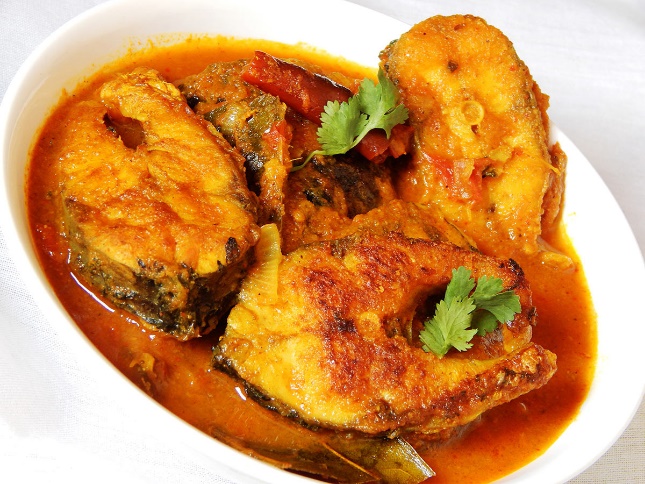 |
Katla Fish:- Katla or Catla also known as major Indian carp is commonly found in rivers and lakes of India and one of the most popular species of freshwater fish. It is native to rivers and lakes in northern India, Bangladesh, Myanmar, Nepal, and Pakistan, but has also been introduced elsewhere in South Asia and is commonly farmed.
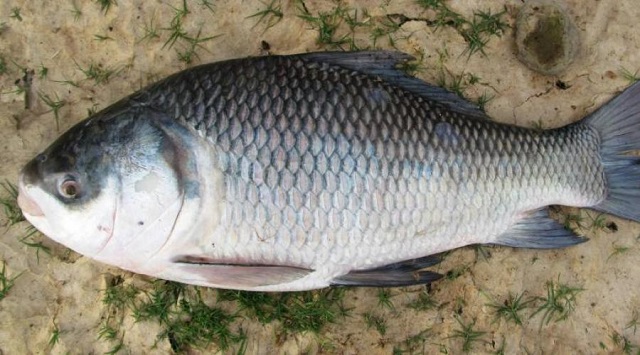 |  |
Hilsa Fish:- Ilish or hilsa shad is a freshwater and brackish water fish, popular in India especially West Bengal, Odisha, Tripura, Assam and Andhra Pradesh. The fish is a popular food in Andhra Pradesh and Bengal. Hilsa is considered as one of the most tastiest fish due to its distinctly soft oily texture, mouthwatering flavour and superb mouthfeel. The fish is locally called “Macher Raja” means the king of fish.
 |  |
Rani – Pink Perch Fish-Rani fish or Pink Perch is a freshwater gamefish, found in different geographical areas of India. The fish is small in size and very commonly sold freshwater fish in India. The Rani fish or the Pink Perch is a sought after fish not only for sporting but also for its taste. It is a wonderful dish to serve in any occasion and taste best when pan-fried. The Perch is cooked when its meat turns opaque but is still moist on the inside. Being a lighter food, it is tender and rich in DHA which is the highest in any freshwater fish.
 |  |
Rawas (Indian Salmon)
Rawas is one of the most loved and popular edible fish. Rawas is widely available in India and is famous for its pink to orange meat with a mild flavor. It is specifically an oily fish, which means it consists of oil almost all over its body. A salmon fillet, which is a boneless piece of fish is said to have around 30% of the oil. This oil is though great for your health containing Omega 3, Vitamin A, and Vitamin D.
 |  |
Bangda (Indian Mackerel)
Indian Mackerel or popularly known as Bangda belongs to the list of staple fishes of India. It is a saltwater fish found in the Indian Oceans and the seas around. The fish is oily and therefore is a great source of protein and Omega 3.
 |  |
Surmai (King Fish/Seer Fish)
The fish is extremely popular as well as an expensive one. It is most popular in South and Central India. Surmai is categorically mackerel and is rich in protein, omega 3 and other vitamins.
 |  |
Pomfret
Pomfret is an exotic fish that is extremely enjoyed in India. It falls under the category of butterfish vastly found in South Asia including the Indian Ocean. The fish is not an oily one and has white meat which is highly-delicious. Silver, white and black pomfret are popular in India.
 |  |
Halibut Fish:- Halibut fish is large member of the flatfish family, it is Firm, white, and mild flavored, halibut is well-suited for just about every cooking method. Its subtle flavor should not be overpowered by aggressive sauces or marinades. Halibut pairs well with tarragon and chives, potatoes, and juicy greens like spinach and Swiss chard.
 |  |
COD FISH- Cod have a lean, mild flavor profile with large flakes and a tender-firm texture. Pacific Cod tend to have thicker fillets with a higher moisture content and are therefore less firm and a little harder to bread/batter. Their flesh is an opaque white color when raw and remains white after cooking. Atlantic Cod are a little sweeter than Pacific Cod, with translucent white to pink-tinged flesh when raw which turns white when cooked.
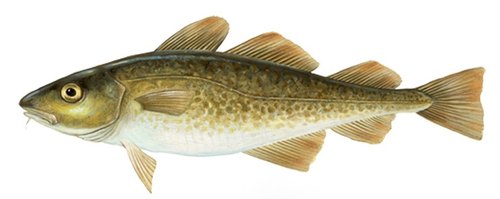 | 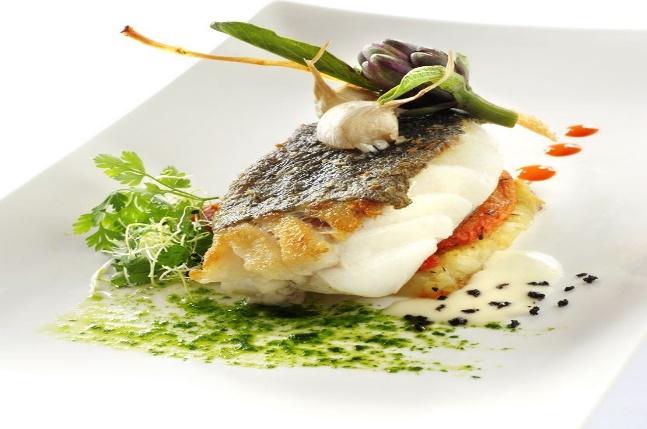 |
Sole fish- The common sole, Dover sole, or black sole (Solea solea) is a species of flatfish in the family Soleidae. It is mild, buttery, sweet flavour and versatility, and for its ease of filleting. The fish yields fillets that hold together well in a variety of recipes.
 | 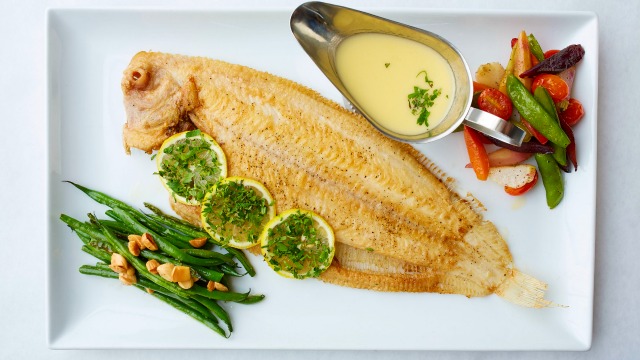 |
Red Snapper- Red snapper is a flavorful white fish that tastes excellent roasted with fresh herbs. Since snapper fillets are so thin, its common to roast the fish whole so no meat goes to waste. If you prefer not to buy a whole fish, you can bake, sauté or deep fry the fillets.
 | 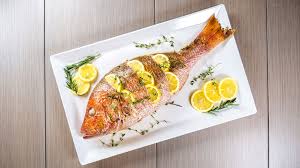 |
Salmon Fish:-
Salmon is a popular food. Classified as an oily fish, salmon is considered to be healthy due to the fish’s high protein, high omega-3 fatty acids, and high vitamin D content. Salmon is also a source of cholesterol, with a range of 23–214 mg/100 g depending on the species Salmon flesh is generally orange to red, although white-fleshed wild salmon with white-black skin colour occurs. The natural colour of salmon results from carotenoid pigments. The vast majority of Atlantic salmon available around the world are farmed (almost 99%)
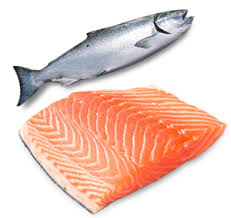 | 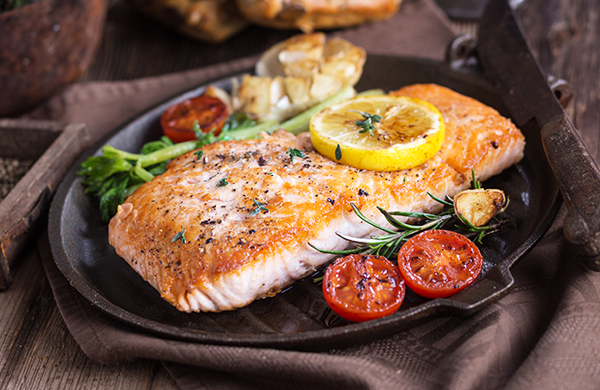 |
Tuna Fish-
Tuna is a saltwater fish that belongs to the mackerel family. Tuna is popularly sold in canned form although fresh tuna is also available. Tuna is canned in edible oils, in brine, in water, and in various sauces.
Unique because of their pink to dark red flesh, tuna is a carnivorous fish specie. Their meat has a flaky texture and rich flavor with high oil content. It has a unique taste, texture and versatility that make it popular around the world. The fish can be baked, grilled, steamed, fried or even minced for a recipe.
Tune is used as a steak and in sandwiches and salads. Tuna can be seared, broiled, smoked, roasted, grilled, fried or stewed. It is also served raw in the form of sushi or sashimi.
 |  |
Mackerel Fish:-
Mackerel is a beautiful oily fish, both for its iridescent, striking skin and its rich, fishy flavour. Respected by chefs and home cooks alike, mackerel has a distinctive flavour, it looks stunning on the plate and is a great source of brain-boosting omega-3 fatty acids .
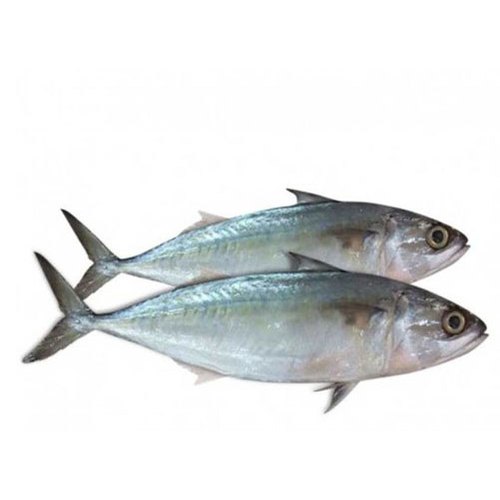 | 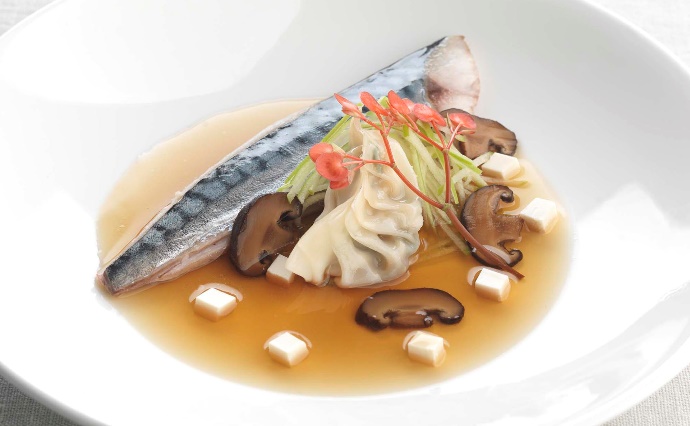 |
Vietnamese Basa fish-
Basa is a type of catfish. Its flesh has a light, firm texture and a mild fish flavor — similar to cod or haddock. In fact, it’s often sold as boneless fish fillets and used in the same way. Basa fish are native to the Mekong and Chao Phraya rivers, which run through several countries in Southeast Asia. Due to its popularity and the high demand, it is now farmed in India specially in Andhra Pradesh & Chennai.
 | 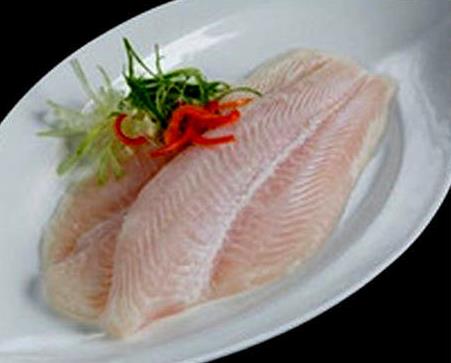 |
Guidelines on Selection of Fresh Fish:-
- Check the eyes for clarity- Before you handle the fish, check the eyes. They should be crystal-clear, plump, wet, and shiny, with no sunken features. If the eyes look good, you can bet with reasonable confidence that the fish is fresh and healthy.
- Check the fins- The tail and dorsal fins of the fish should be healthy-looking, wet, and intact. A fish that’s been mishandled will have torn or ragged fins, while an older fish’s fins will be dry and brittle.
- Poke the flesh- If the fish monger allows it, try touching the fish for further signs of health and freshness. It should feel cold, wet, and slippery, but not sticky. When pressed, it should spring back to its natural shape
- Check the gills- Check the gills for vitality and color. When first caught, a fish’s gills appear bright red, and slowly darken over time. The brighter the color, the fresher the fish. The gills should also feel clean and cold, not slimy.
- Touch the Fish scales- Scales are designed to protect the fish from a harsh watery environment. When a fish is fresh, the scales will be shiny and firm. Less-fresh fish will often shed scales as you run your hand over them, and they may appear dry and flaky.
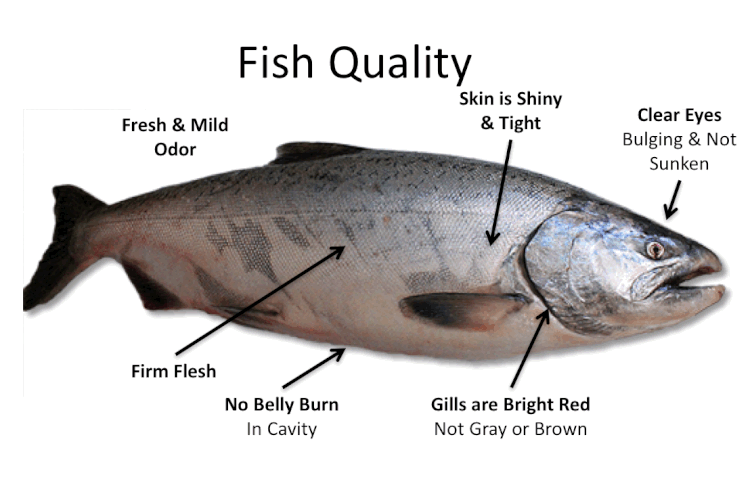
Suitable temperature for storing of Fish
Ideally, fish should be consumed as fresh as possible to retain its flavor and texture. However, most fish can be frozen for later use but only after cleaning it of all internal organs. For very short time storage, fish must be stored at refrigerated temperatures of 3-5°C. Fish should be cooked soon after cleaning and marinating. Where as for longer storage of fish it should be stored at minimum -18 degree C or Below. Commercially frozen fish is generally of very high quality and can be an excellent value. It also has a much longer shelf life than fish frozen at home. The best way to defrost any frozen seafood is slowly in the refrigerator. This will take 12 to 18 hours (overnight) depending on the size of the piece of fish.
Store fresh fish covered with ice at 29-32°F /-2 0°C, in a self-draining perforated pan and replenish the ice as needed.
Various Cuts of Fish & its use in Cooking
Fillet Cut of Fish-
The flesh of the fish is completely cut from the bone in its natural form. Flat fish yield four fillets, e.g. sole, plaice, halibut. Round fish yield two fillets, e.g. cod, whiting, salmon, herring. They are suitable for poaching, shallow and deep frying, grilling and baking.
Suprême:
This term generally applies to fillets of large fish cut into small pieces or portions on the slant, e.g. suprême of halibut or turbot. They are suitable for poaching, shallow and deep frying, grilling and baking.
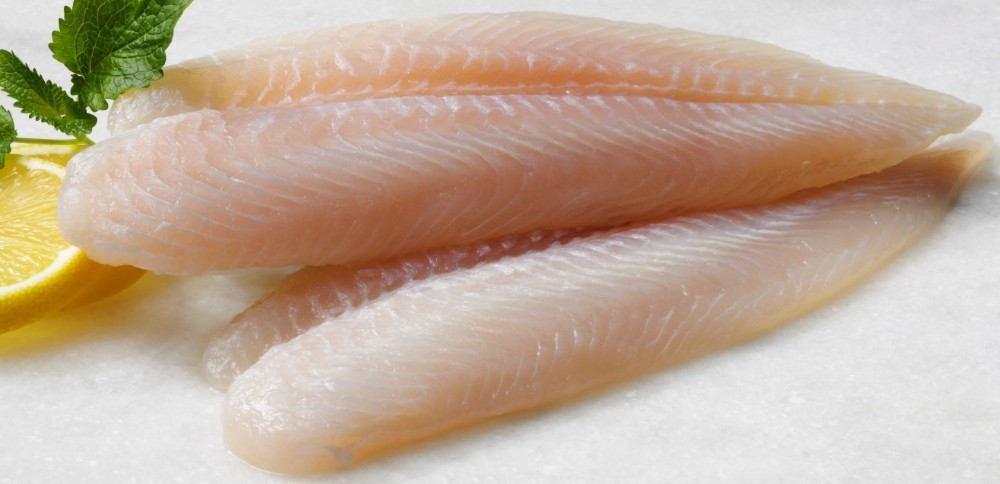 | 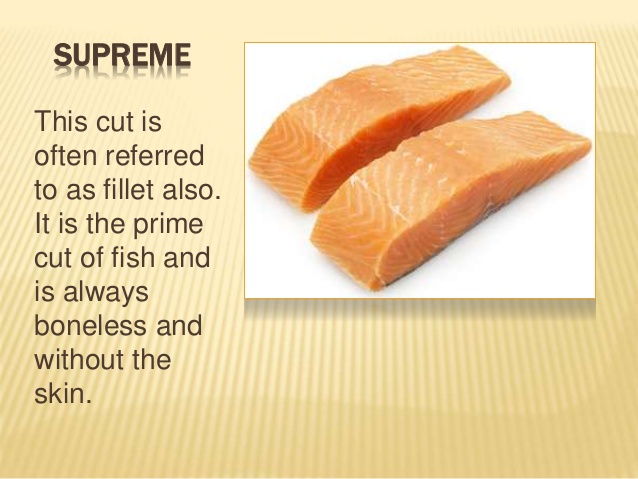 |
Goujons and goujonettes:
This term refers to fillets of fish cut on the slant into small strips approximately 6-8 cm x 1cm. Though generally applying to fillets of small fish, there is no reason why larger fish fillets may not be cut into goujons. As the name implies goujonettes are a smaller version of goujons and are cut into strips 3-4 cm x 5 mm. Both goujons and goujonettes are suitable for deep frying and shallow frying and are sometimes poached.
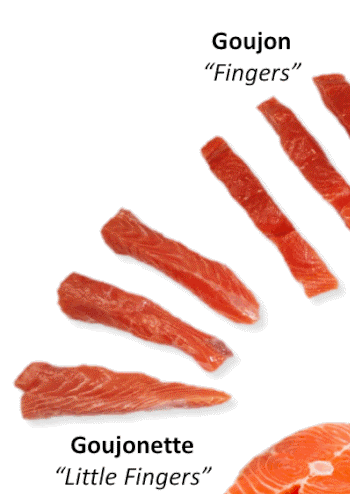
Tronçon & Darne cut of Fish:
This is a slice weighing 180–250 g cut on the bone from a large flat fish such as halibut, turbot or brill. They are suitable for boiling and grilling. It is taken from Flat fish.
Darne:-This is a slice cut from round fish on the bone, each portion weighing the same as a tronçon. The term applies to large round fish such as cod, fresh haddock and salmon. They are suitable for boiling, grilling and shallow frying.
| Troncon Cut from Flat fish | Darne Cut from Round |
 | 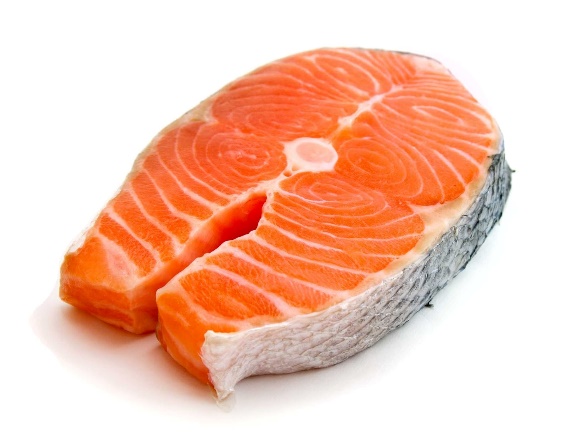 |
Délice cut of Fish:
A variation of fillet of small flat fish, this consists of a quarter of the head end and a quarter of the tail end of the fillet folded under, the skin side being folded inwards. They are suitable for poaching.
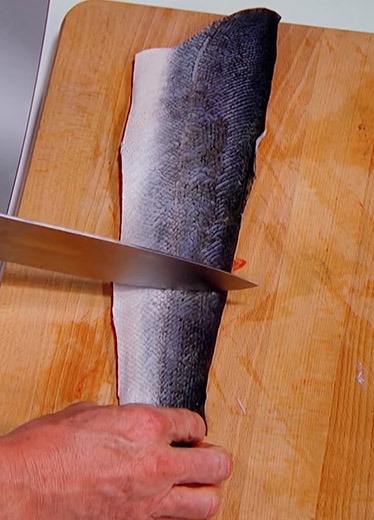
Paupiette cut of Fish:
Another variation of fillet of small flat fish, for this the fillet is spread with a fish stuffing and rolled skin side innermost. The fish stuffing — referred to as Farce de Poisson – consists of finely minced fish (usually whiting) combined with egg whites and cream. They are suitable for poaching.
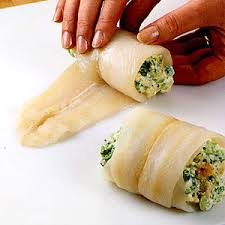
Shellfish
SHELL FISH: As the name suggests, shellfish are animals that dwell in water and have a shell or shell-like exterior.
They can be divided into two groups: crustaceans and mollusks. Crustaceans include shrimp, crayfish, crab, and lobster, while clams, scallops, oysters & Mollusks– which are again subdivided into univalves & Bi-valve.
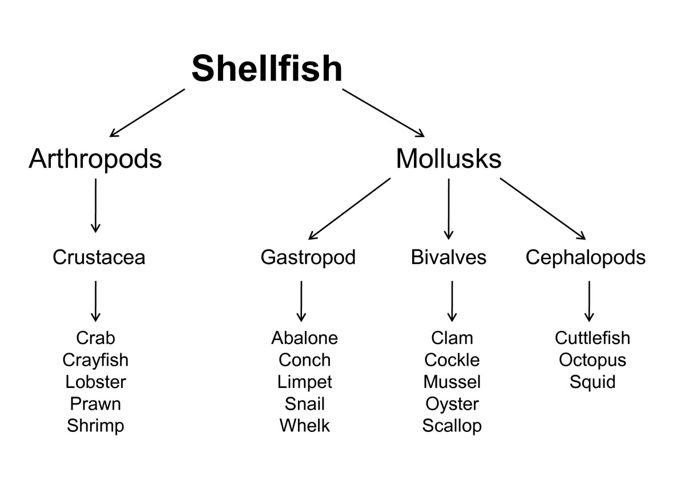
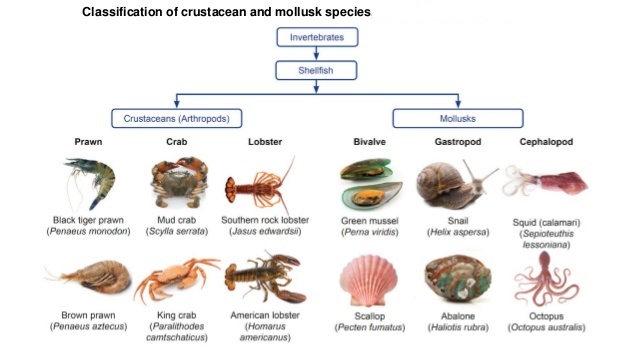
What is Crustaceans :-
Crustaceans are group of ten legged lobsters types include: prawns, crawfish (also called spiny or rock lobster), sea lobster, North sea crabs, crayfish, hermit crabs, coconut crab, fiddler crab, Chinese mitten crab, land crab and snapping shrimp.
They are classified as follows:
- The simple ten-legged types, the prawn-like types
- The hard shelled lobsters which are sub divided in
- Long tailed sea-bed lobsters
- The Anomura – between the long tailed and short tailed lobster types (hermit or sand crabs)
- The original or short tailed crabs (North sea crab)
Shrimp & Prawn:- Shrimp & Prawn are decapod crustaceans with elongated bodies. Under a broader definition, shrimp may be synonymous with prawn. Shrimp are widespread and abundant. The body of the shrimp is divided into two main parts: the head and thorax which are fused together to form the cephalothorax, and a long narrow abdomen. Shrimp are widespread, and can be found near the seafloor of most coasts and estuaries, as well as in rivers and lakes. Most shrimp species are marine, although about a quarter of the described species are found in fresh water. The major producer of farmed shrimp is China. Other significant producers are Thailand, Indonesia, India, Vietnam, Brazil, Ecuador and Bangladesh. Most farmed shrimp is exported to the United States, the European Union and Japan.
Most shrimp are sold frozen and marketed based on their categorization of presentation, grading, colour, and uniformity. Shrimp have high levels of omega-3 fatty acids and low levels of mercury. Most shrimp are sold frozen and marketed based on their categorization of presentation, grading, colour, and uniformity. Shrimp have high levels of omega-3 fatty acids and low levels of mercury. A shrimp-based meal is also a significant source of cholesterol, from 122 mg to 251 mg per 100 g of shrimp, depending on the method of preparation.
Shrimp & Prawn size chart
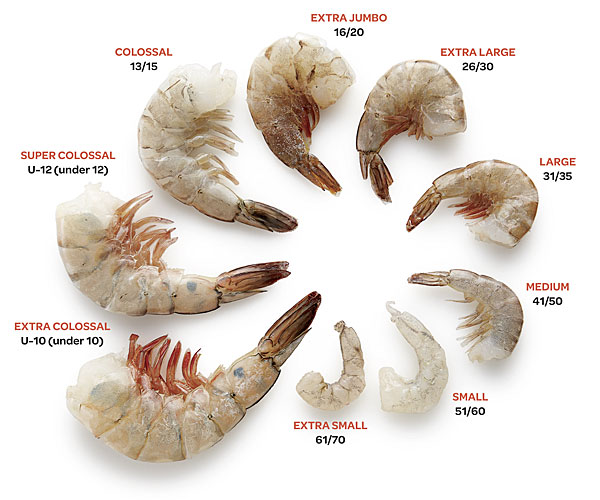
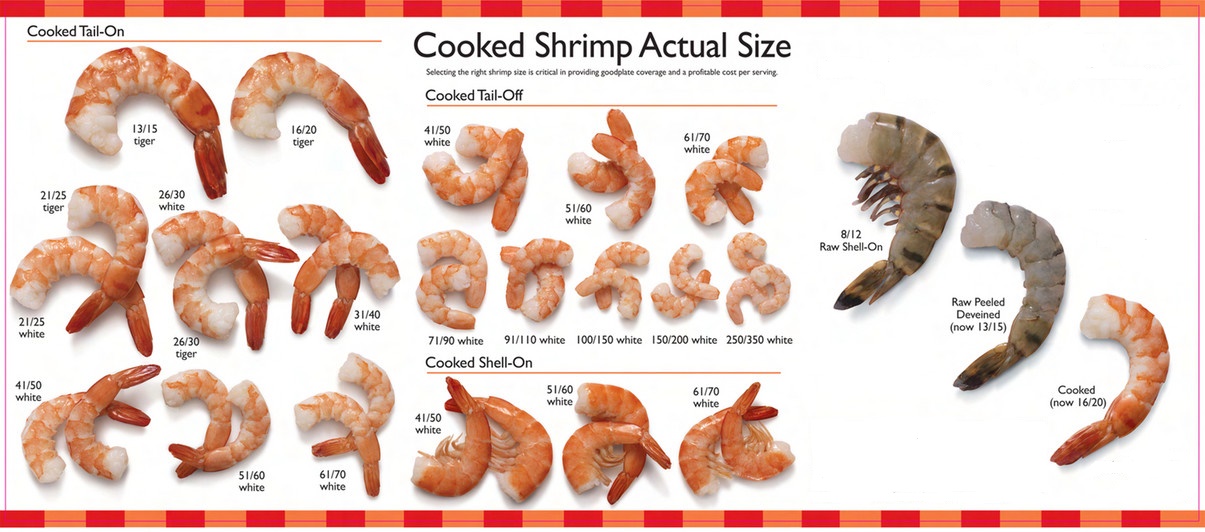
What is Crab:-
Crabs are decapod crustaceans. Out of the 4,400 varieties of crab, only a few are popular edible varieties: The majority of edible crabs have five pairs of legs, with the front legs being the larger pincers. They can live in both shallow and deep-sea waters. Crabs are prepared and eaten as a dish in many different ways all over the world. Some species are eaten whole, including the shell, such as soft-shell crab; with other species, just the claws or legs are eaten.
What is Soft-shell crab is a culinary term for crabs that have recently molted their old exoskeleton and are still soft. In Japan, various species are used to make sushi such as maki-zushi or temaki-zushi.
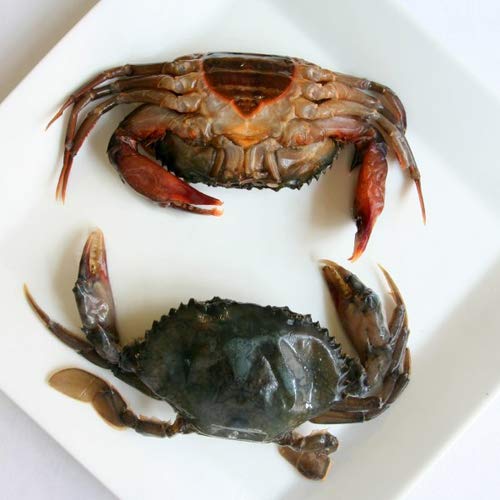
How to cook crab:-
- Freeze the Crab before cooking– In order to handle the crab before cooking it is very much required to freeze your crab by placing it in Refrigerator. The cold air will numb the crabs and cause them to move around much slower.
- Spike the crab to kill it. You can quickly pierce the two nerve centers on a crab to immediately and painlessly kill the crab. This is directly over a nerve center. Take a knife (or awl) and spike into this tiny hole at an angle of 85°.

Cooking of Crab by either Boiling or Steaming-
The best way to cook the crab is either by boiling it or steaming it until it is cooked. Approx 7-10 mintutes will take to steam the Crab where as boiling takes around 20 mintues to cook the crab.
. 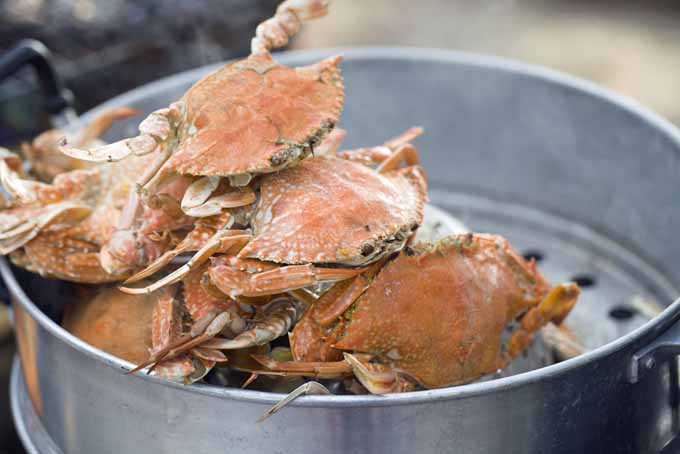
What is Lobster –
Lobster are a family of large marine crustaceans and have long bodies with muscular tails. Typically, lobsters are dark colored, either bluish green or greenish brown. The king of the crustaceans, lobster is a delicacy that commands a very high price, with white, firm meat that is sweet and succulent. Before it is cooked, lobster shell has a very dark colour, with tints that range from blue/green to red/purple – it gains its distinctive deep red brick colour only when it’s cooked. There are three main types: Canadian or American, which have round, very fleshy claws; European, fished around England, Scotland, Ireland, Brittany and Norway, which are considered to have the best flavour; and Slipper or Squat lobster, which live in warmer oceans, such as those surrounding Australia, where they are called ‘bugs’. They have wide bodies and spindly legs, and aren’t generally sold in Europe.
Lobster is used in soup, bisque, lobster rolls. Lobster meat may be dipped in clarified butter, resulting in a heightened flavor. Cooks boil or steam live lobsters. When a lobster is cooked, its shell’s color changes from blue to orange because the heat from cooking breaks down a protein called crustacyanin, which suppresses the orange hue of the chemical astaxanthin, which is also found in the shell

What is
Mollusca is one of the most diverse groups of animals on the planet. It includes such familiar organisms as snails, octopuses, squid, clams, scallops, oysters etc. Molluscs are a clade of organisms that all have soft bodies which typically have a “head” and a “foot” region. Often their bodies are covered by a hard exoskeleton, as in the shells of snails and clams or the plates of chitons.
Edible molluscs are harvested from saltwater, freshwater, and the land, and include numerous members of the classes Gastropoda (snails), Bivalvia (clams, scallops, oysters etc.), Cephalopoda (octopus and squid). Many species of molluscs are eaten worldwide, either cooked or raw
Gastropods (snails)- “Gastropod” means “stomach foot” which is inaccurate because the stomach is up inside the shell. Land snails need a lot more pre-preparation than sea or fresh water snails because of the slime they depend on for getting around. Basic preparation for small snails is to keep them away from food for 2 to 5 days depending on species to clean out their digestive tract. Land snails then need to be de-slimed by application of salt or by other means.
Varieties of Snails-
Abalone- There are eight species of abalone off the coast of California. Red abalone can get up to a foot long but not many get much beyond the 7 inch minimum.
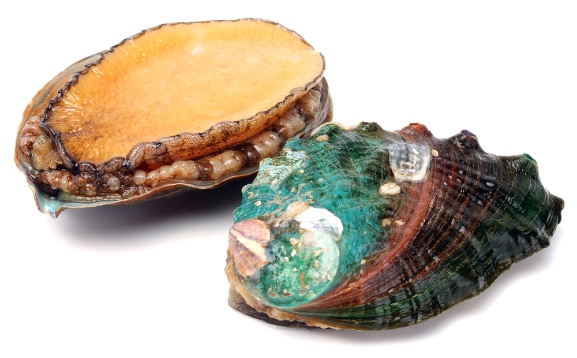 |  |
Brown Garden Snail- Humans have consumed Land snails for thousands of years. They are low in fat, high in water and proteins and are part of several dishes. Its consumption is not very common in areas of America, but in Europe, they have meals considered delicacies. The Romans had a significant history of eating snails. Land snails are part of the European cuisine. It is no secret that many people find snails to be delicious as an appetizer or as a main course. In Greece and Italy snail are often consumed in a variety of meals, and sometimes they are used in sauces and poured over various types of pasta. People from other countries like Spain, Portugal, and Germany also consume them
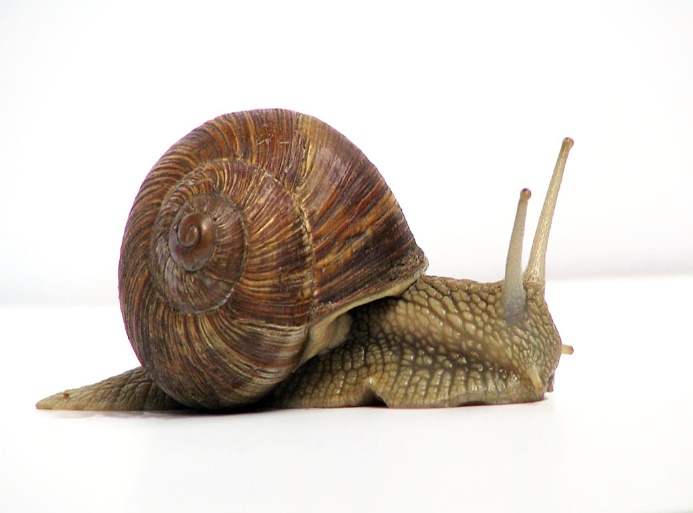 | 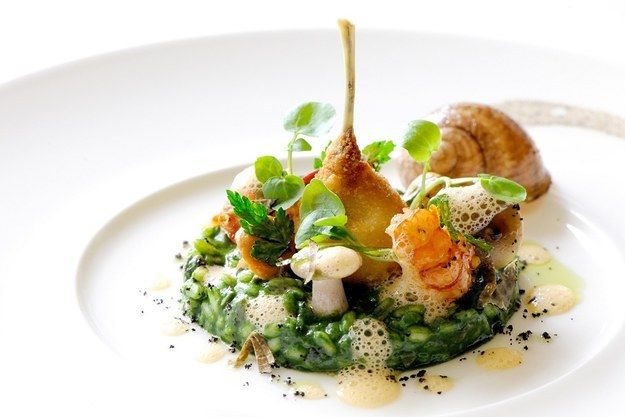 |
Bivalve- The most important feature of a bivalve is its two shells, called valves. These shells act like a protective armor, guarding the bivalve’s soft inner body parts. They can open their shells to move and feed.
Bivalves are aquatic animals, and different species of bivalves can be found in freshwater, saltwater and even brackish, slightly salty, water environments. They typically live on the seafloor, on seabeds or attach themselves to the sides of hard surfaces, like rocks or manmade pipes.
Example of Popular Bivalve are-

Oysters:- A bivalve mollusk, which is eaten raw or cooked. The Oyster’s size, shape, texture and flavor will vary according to the area in which it is found. Their texture varies from soft to firm and their taste varies from bland to salty. The flavor of the meat is dependent on the characteristics of the region in which the Oyster matures. Store oysters in the bottom of the fridge, rounded side down so they don’t leak any juice.
How to prepare an oyster
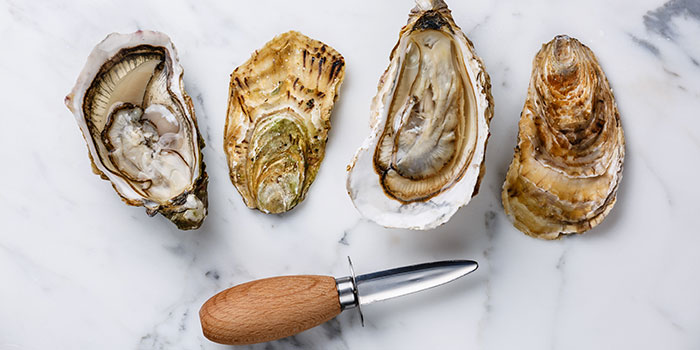
Closed oysters need to be ‘shucked’, which is something all fishmongers can do for you, but if you fancy taking it on yourself, it’s best to use a specialist oyster knife, which is short and blunt with a finger guard.
1. Hold the oyster very firmly in a thick cloth to protect your hands, then insert the knife into the hinge, or pointed end, of the oyster.
2. Twist the tip of the knife into the hinge to get a very firm foothold. Once you feel the knife is securely in place, release the pressure from the knife and gently lever or twist the knife to break the muscle of the oyster – you can usually hear the ‘shucking’ noise as the two half shells part.
3. Loosen the opened oyster from the shell to make it easy to eat.
How to serve oysters
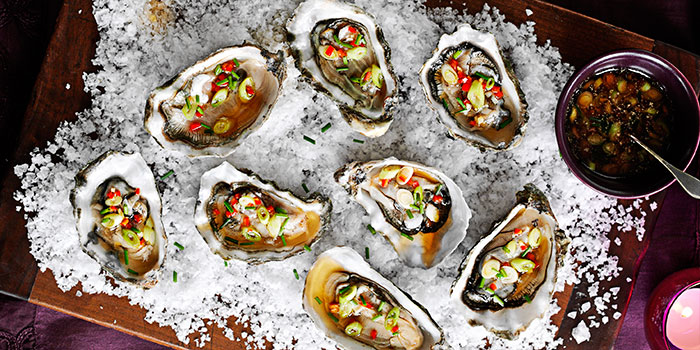
The customary approach to eating oysters is to serve them raw. Typically, raw oysters are served on the half shell with plenty of lemon for squeezing, Tabasco sauce and shallot vinaigrette (mignonette). The briney, sodium-rich flavour of oysters means they partner well with tangy Asian-style dressings, such as this spicy sauce
Clam- Clam is a common name for several kinds of bivalve molluscs Clams have two shells of equal size connected by two adductor muscles and have a powerful burrowing foot Clams are found in freshwater and are also sometimes eaten raw, but are also great candidates for frying and breading. Clams are eaten more in the coastal regions of India, especially in the Konkan, Kerala, Bengal and coastal regions of Karnataka regions. In Kerala clams are used to make curries and fried with coconut.
The steam-method for cooking clams is excellent for cooking small to medium-sized varieties of clam. Signature clam dishes include New England clam chowder and Manhattan clam chowder. Fried clam fritters (also known as fannie daddies and boat-steerers) and clams casino with tempting ingredients like bacon, butter, and red bell pepper are two more American favorites. lams may be substituted in most oyster, scallop, and mussel recipes, and vice versa.
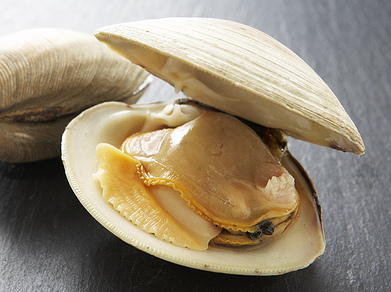 |  |
Scallop- Scallops are a bivalve mollusk of the Pectinidae family and are related to clams, mussels, and oysters. There are many varieties of scallop, but the most common is the tiny bay scallop, found in East Coast bays and estuaries, and the larger sea scallop, which exists in the deep cold waters on the ocean floor. Bay scallops are most often less expensive than sea scallops, especially when the sea scallops are very large. No matter the type, the scallop should be a pale pink or light beige color with a soft texture.
Inside the shell, scallops have a white adductor muscle (the part we to eat) that opens and closes the shell, as well as a bright orange section called the coral. The muscle is round and tender when cooked, with both a touch of sweetness and briny saltiness.
There are two types of scallops: Bay scallops and sea scallops. The bay variety are smaller (about the size of a dime) and more tender, while sea scallops are larger, growing as big as two inches.
 | 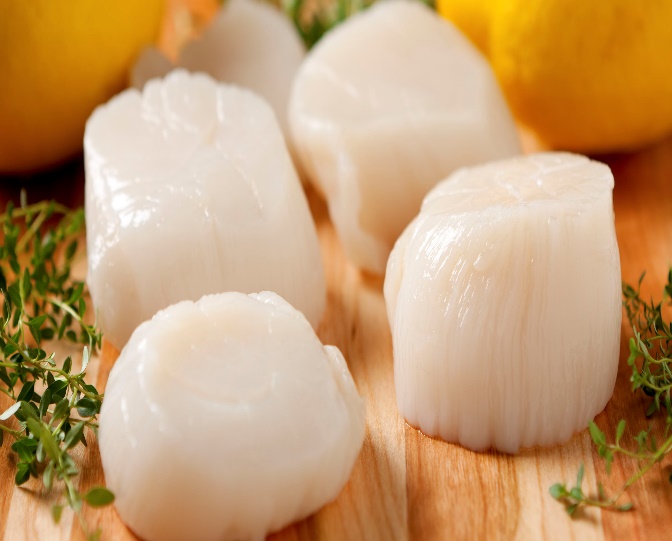 |
Mussels- A mussel is a type of bivalve mollusk that can be found in fresh water lakes, streams, and creeks, along with the salty inter-tidal zone where oceans meet the shore. Like many other shellfish, they are cultivated and caught in the wild to serve as food for humans, and they also have a number of predators in the natural environment. This mollusk is also much more popular in Europe and parts of the Asia than North America, where only a small portion of the population is interested in mussels as a food source.
 | 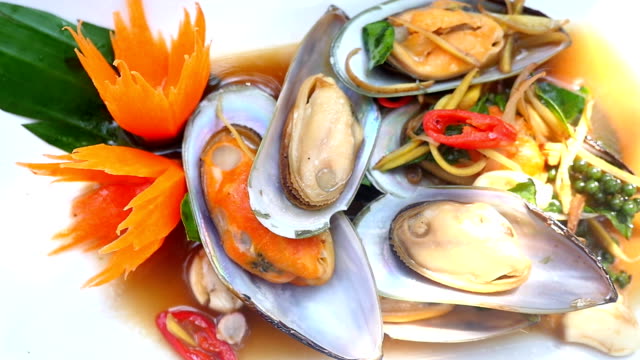 |
Choose the best the best mussels-
Try not to choose mussels that have chipped, broken or damaged shells. Fresh mussels tend to be tightly closed. Allow about 500g per person for a main meal, and half that amount for a starter, or if they are to be added to pasta or soup. Mussels are highly perishable and should be eaten on the day of purchase.
How to Prepare it
To clean mussels, scrub in plenty of cold water to remove barnacles or sand. Discard any that float to the top. Give any open mussels a sharp tap with a knife and discard any that fail to close (they are dead). Remove the ‘beard’ – a fibrous clump of hairs that sprouts from the shell – by giving it a sharp tug towards the hinge end of the mussel. Place cleaned mussels in a fresh bowl of cold water until ready to use. Change this water two or three times to remove any salt or sand that the mussels may expel.
What is Cephalopods- Cephalopoda is a class of invertebrate animals (without a backbone) that includes animals like the octopus, the squid, the cuttlefish.
Squid and octopus are among the cephalopods that are used as a food source.
Squid:- Squid is eaten in many cuisines; in English, the culinary name calamari is often used for squid dishes. squid are cephalopods recognizable for their elongated, soft bodies and long arms and tentacles. Squid has thin, mild flesh compared with octopus and cuttlefish, which have thicker, more flavorful meat like that of crab or lobster. Unlike fish and shellfish, raw squid meat is smooth and firm. When prepared properly, calamari becomes tender and absorbs the flavors it’s cooked with. Otherwise, it can become chewy and bland.
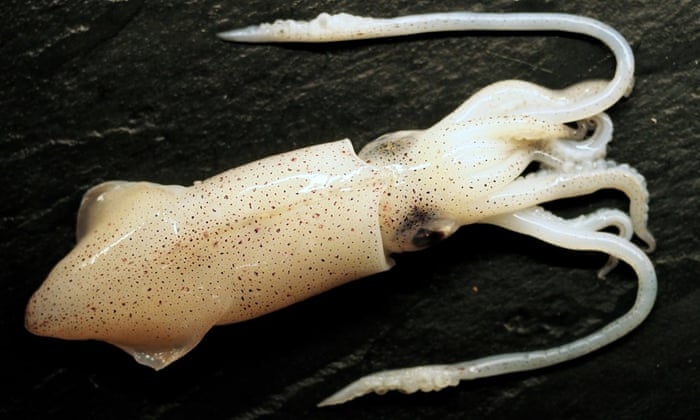 | 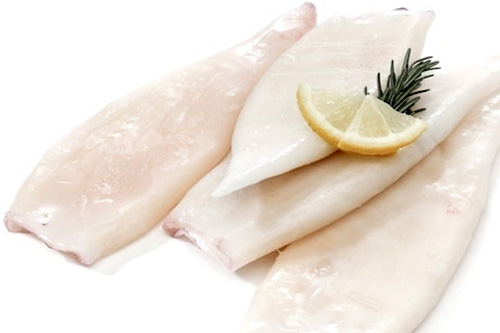 |
Octopus- is a soft-bodied, eight-limbed mollusc of the order Octopoda. Octopus is a low-calorie food and it is also very filling. It also contains a variety of vitamins that are needed by the body. The Greek love to create dishes with the Octopus being grilled over an open flame.
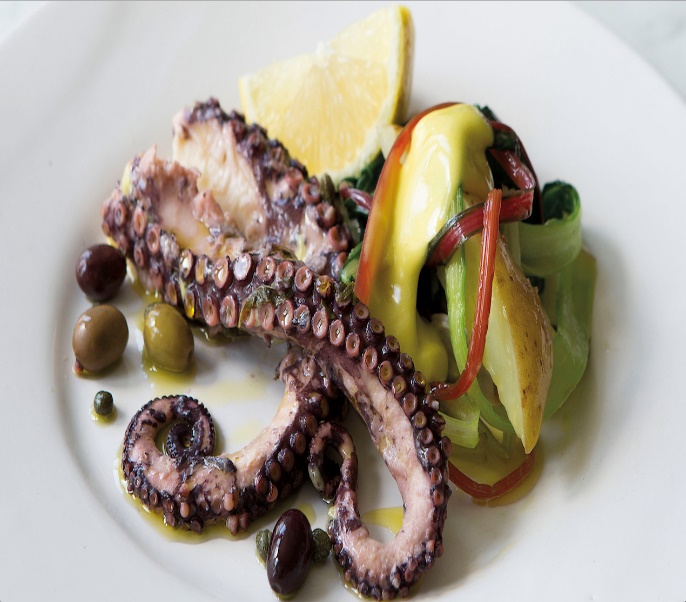 |  |
